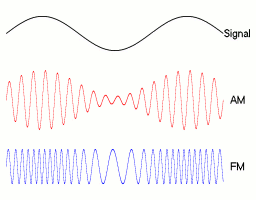Frequency modulation
Frequency Modulation (FM) is a method of modulating a signal where the frequency of the carrier wave is varied in accordance with the amplitude of the input signal. This technique contrasts with amplitude modulation (AM), where the amplitude of the carrier wave is varied while its frequency remains constant. FM is widely used for broadcasting music and speech, with applications ranging from radio broadcasting to television and beyond.
Overview[edit | edit source]
In frequency modulation, the information (such as music or voice) to be transmitted modulates the frequency of the carrier wave, rather than its amplitude. This has the advantage of being more resistant to signal degradation and noise, making FM a preferred method for high-fidelity broadcasts. The concept of FM was patented by Edwin Armstrong in 1933, who was looking for a solution to the problem of electrical noise in radio transmission.
Principles of Operation[edit | edit source]
The basic principle behind FM is simple: the frequency of the carrier wave is changed in direct proportion to the changes in the amplitude of the modulating signal. When the amplitude of the input signal increases, the frequency of the carrier wave increases. Conversely, when the amplitude decreases, the frequency decreases. This variation creates a frequency modulated signal that can be transmitted over a medium to a receiver, which demodulates it to recover the original signal.
FM Bandwidth[edit | edit source]
The bandwidth of an FM signal is determined by the Carson's Rule, which states that the total bandwidth required for FM transmission is approximately twice the sum of the maximum deviation frequency and the highest frequency of the modulating signal. This means that FM stations require more bandwidth than AM stations, but the trade-off is improved sound quality and reduced susceptibility to noise.
Applications[edit | edit source]
FM is used in a wide range of applications, including:
- Radio broadcasting: FM radio offers high-quality sound over AM radio, making it ideal for music and entertainment broadcasting. - Television audio: FM is used for the audio component of television broadcasts, providing clear sound quality. - Two-way radios: Many two-way radio systems, including those used by police and emergency services, utilize FM for clear, reliable communication. - Radar and seismic data analysis: FM techniques are applied in radar and in analyzing seismic data for oil exploration and earthquake research.
Advantages and Disadvantages[edit | edit source]
The primary advantage of FM over AM is its resistance to static and electrical interference, which results in a clearer, more consistent sound quality. However, FM signals have a relatively shorter range than AM signals, especially in areas with physical obstructions like buildings or mountains. Additionally, the wider bandwidth of FM means that fewer stations can fit within a given frequency range.
See Also[edit | edit source]
- Amplitude Modulation - Radio Wave - Broadcasting - Signal Processing
This communication related article is a stub. You can help WikiMD by expanding it.
Search WikiMD
Ad.Tired of being Overweight? Try W8MD's physician weight loss program.
Semaglutide (Ozempic / Wegovy and Tirzepatide (Mounjaro / Zepbound) available.
Advertise on WikiMD
|
WikiMD's Wellness Encyclopedia |
| Let Food Be Thy Medicine Medicine Thy Food - Hippocrates |
Translate this page: - East Asian
中文,
日本,
한국어,
South Asian
हिन्दी,
தமிழ்,
తెలుగు,
Urdu,
ಕನ್ನಡ,
Southeast Asian
Indonesian,
Vietnamese,
Thai,
မြန်မာဘာသာ,
বাংলা
European
español,
Deutsch,
français,
Greek,
português do Brasil,
polski,
română,
русский,
Nederlands,
norsk,
svenska,
suomi,
Italian
Middle Eastern & African
عربى,
Turkish,
Persian,
Hebrew,
Afrikaans,
isiZulu,
Kiswahili,
Other
Bulgarian,
Hungarian,
Czech,
Swedish,
മലയാളം,
मराठी,
ਪੰਜਾਬੀ,
ગુજરાતી,
Portuguese,
Ukrainian
Medical Disclaimer: WikiMD is not a substitute for professional medical advice. The information on WikiMD is provided as an information resource only, may be incorrect, outdated or misleading, and is not to be used or relied on for any diagnostic or treatment purposes. Please consult your health care provider before making any healthcare decisions or for guidance about a specific medical condition. WikiMD expressly disclaims responsibility, and shall have no liability, for any damages, loss, injury, or liability whatsoever suffered as a result of your reliance on the information contained in this site. By visiting this site you agree to the foregoing terms and conditions, which may from time to time be changed or supplemented by WikiMD. If you do not agree to the foregoing terms and conditions, you should not enter or use this site. See full disclaimer.
Credits:Most images are courtesy of Wikimedia commons, and templates, categories Wikipedia, licensed under CC BY SA or similar.
Contributors: Prab R. Tumpati, MD


